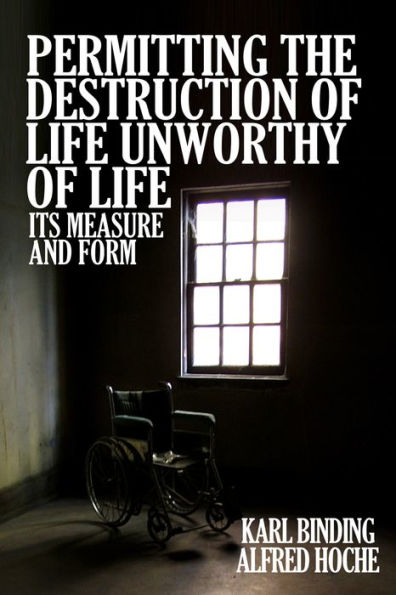Permitting the Destruction of Life Unworthy of Life
In 1920, Karl Binding and Alfred Hoche, two German professors of high regard, published their two part argument that there were lives that were not worthy of living, and society not only had the right, it had the duty, to put such lives out of their 'misery.'
Binding and Hoche were not radical racists. They were not National Socialists or intellectual henchmen for the Nazis. They were scholars, merely rendering their sober judgement on a topic based on advances in science and ethics.
How then did their book serve as a catalyst for Hitler's horrors? Few realize that before there were 'extermination' camps, there was the "Action T4" program, that quietly eliminated mentally ill and disabled people of all ages... and these were fellow Germans! The techniques for mass murder were mastered in the T4 program and later exported to the concentration camps. From beginning to end, these policies were considered medical in nature, and thus doctors--who had imbibed on Binding and Hoche's ethical arguments--were front and center in their implementation.
In this new translation of "Die Freigabe der Vernichtung Lebensunwerten Lebens" by Dr. Cristina Modak, commissioned by the Policy Intersections Research Center, readers can see for themselves what ideas drove the Holocaust. They are invited to consider whether or not any of them might seem familiar.
More:
"1122509071"
Binding and Hoche were not radical racists. They were not National Socialists or intellectual henchmen for the Nazis. They were scholars, merely rendering their sober judgement on a topic based on advances in science and ethics.
How then did their book serve as a catalyst for Hitler's horrors? Few realize that before there were 'extermination' camps, there was the "Action T4" program, that quietly eliminated mentally ill and disabled people of all ages... and these were fellow Germans! The techniques for mass murder were mastered in the T4 program and later exported to the concentration camps. From beginning to end, these policies were considered medical in nature, and thus doctors--who had imbibed on Binding and Hoche's ethical arguments--were front and center in their implementation.
In this new translation of "Die Freigabe der Vernichtung Lebensunwerten Lebens" by Dr. Cristina Modak, commissioned by the Policy Intersections Research Center, readers can see for themselves what ideas drove the Holocaust. They are invited to consider whether or not any of them might seem familiar.
More:
Permitting the Destruction of Life Unworthy of Life
In 1920, Karl Binding and Alfred Hoche, two German professors of high regard, published their two part argument that there were lives that were not worthy of living, and society not only had the right, it had the duty, to put such lives out of their 'misery.'
Binding and Hoche were not radical racists. They were not National Socialists or intellectual henchmen for the Nazis. They were scholars, merely rendering their sober judgement on a topic based on advances in science and ethics.
How then did their book serve as a catalyst for Hitler's horrors? Few realize that before there were 'extermination' camps, there was the "Action T4" program, that quietly eliminated mentally ill and disabled people of all ages... and these were fellow Germans! The techniques for mass murder were mastered in the T4 program and later exported to the concentration camps. From beginning to end, these policies were considered medical in nature, and thus doctors--who had imbibed on Binding and Hoche's ethical arguments--were front and center in their implementation.
In this new translation of "Die Freigabe der Vernichtung Lebensunwerten Lebens" by Dr. Cristina Modak, commissioned by the Policy Intersections Research Center, readers can see for themselves what ideas drove the Holocaust. They are invited to consider whether or not any of them might seem familiar.
More:
Binding and Hoche were not radical racists. They were not National Socialists or intellectual henchmen for the Nazis. They were scholars, merely rendering their sober judgement on a topic based on advances in science and ethics.
How then did their book serve as a catalyst for Hitler's horrors? Few realize that before there were 'extermination' camps, there was the "Action T4" program, that quietly eliminated mentally ill and disabled people of all ages... and these were fellow Germans! The techniques for mass murder were mastered in the T4 program and later exported to the concentration camps. From beginning to end, these policies were considered medical in nature, and thus doctors--who had imbibed on Binding and Hoche's ethical arguments--were front and center in their implementation.
In this new translation of "Die Freigabe der Vernichtung Lebensunwerten Lebens" by Dr. Cristina Modak, commissioned by the Policy Intersections Research Center, readers can see for themselves what ideas drove the Holocaust. They are invited to consider whether or not any of them might seem familiar.
More:
4.99
In Stock
5
1

Permitting the Destruction of Life Unworthy of Life
120
Permitting the Destruction of Life Unworthy of Life
120eBook
$4.99
Related collections and offers
4.99
In Stock

Product Details
| BN ID: | 2940150771000 |
|---|---|
| Publisher: | Athanatos Publishing Group |
| Publication date: | 08/12/2015 |
| Sold by: | Barnes & Noble |
| Format: | eBook |
| Pages: | 120 |
| File size: | 288 KB |
From the B&N Reads Blog
